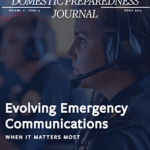In emergency management (EM), the landscape of incoming professionals is evolving from second-career professionals to first-career college graduated practitioners. This change spotlights the difference between management and leadership and its effects on the retention and burnout of professionals. EM professionals see growth in organizations, with “projected growth between 2016 and 2026 to be around 8%” states Columbia Southern University. Issues and gaps inside the EM field or ecosystem become even more apparent when the severity of and damages related to an incident or event increase.
Burnout in EM
Burnout and retention of EM professionals are growing issues within the EM field and a valuable lesson for leadership. These lasting effects within the field also have secondary effects damaging the output of professionals. Leaving them with traumatic stress, compassion fatigue, and lower levels of quality of life. Other professions have a wealth of best practices for staff management and retention, but the application of these practices often differs between industries. In addition, research, studies, articles, and news cycles frequently focus their discussions on the disaster, incident, or event while providing limited focus on the personnel, organization, or structure within EM departments.
“Understanding the Burn Out Experience” describes burnout as:
[A] psychological syndrome emerging as a prolonged response to chronic interpersonal stressors on the job. The three key dimensions of this response are an overwhelming exhaustion, feelings of cynicism and detachment from the job, and a sense of ineffectiveness and lack of accomplishment.
This and other research highlight the correlation between higher burnout and lower empathy levels. Furthermore, such research on burnout demonstrates how just one factor like empathy can directly correlate with maintaining and increasing retention of EM professionals.
To reduce burnout and increase retention, agencies and organizations should focus on the individuals serving in the EM profession, which encompasses many responsibilities, including high-stress roles, political pressure, life safety, vulnerable infrastructure, and community vulnerabilities. In addition to incident management, they must simultaneously sustain their daily operational duties within the organization and the broader profession. The people directly involved in the emergency response efforts of their communities may require additional support beyond the existing departmental human resource practices. Yet, more research is needed on the organizational structure and employee retention or development in EM outside of preparing for the next disaster.
Existing research shows how Maslow’s Hierarchy of Needs plays a role. When the basic personal needs and responsibilities are met, operational levels are higher because practitioners are not as worried about their family’s needs, personal safety, or mental, emotional, and physical wellbeing while on the job. Another theory by Maslow on Human Motivation states, “practically everything looks less important than safety… A man, in this, state, if it is extreme enough and chronic enough, may be characterized as living almost for safety alone.”
Three Ways to Reduce Burnout
The EM profession requires proactive, not just reactive, efforts to support personnel that extend to the recruiting, development, and sustainment of departments, teams, and leadership. Gayle Capozzalo from the American College of Healthcare Executives recommended three preemptive strategies in The Preventative Measures of Burnout – lead with care, invest in psychological support, and look at the schedule.
Leading With Care
A mastery of soft skills and leadership abilities are needed to understand one’s team and have genuine interactions and meaningful conversations. With active listening, subordinates, managers, and colleagues can become leaders and friends in the workplace that assist with cultivating a culture of care and value. Leading with care is a limited skillset within EM, likely due to a limited awareness by the general population regarding EM. More awareness in the field would create a more diverse pool of applicants and practitioners. The professional infrastructure of EM has been continually improving and developing since the Cold War. However, there is still an opportunity for expanded advancement in this profession, where certifications are respected, and advanced education is valued for advancing beyond entry-level opportunities. Leading with care extends to the person, the team, the culture, and the change that will come forth as the field evolves beyond just the grey skies (i.e., activation) times.
Investing in Psychological Support
The second strategy is to invest in the office’s psychological support and mental health. The strain and elevated stress of responding to or being exposed to high-stress environments at regular intervals can have lasting effects on the personnel. Developing preventative measures, offering ample recharge time, and taking opportunities to provide value to the staff at all levels help mitigate the impact of working during stressful events. Not taking care of the mental space can have a negative effect on emotions and result in diminished performance and teamwork issues. Some online sources support stress reduction even though they may not quell the source of the stress. For example, this self-paced online program for healthcare workers is also applicable as a resource to other organizations’ wellness and mental health efforts. As the hit film Remember the Titans mentioned, “Attitude reflects leadership.” Attitude – regardless of the role of the person within the organizational structure – can have positive outcomes and effects on a staff’s cooperation and mental well-being or have the exact opposite effect.
Looking at the Schedule
Working longer hours is a significant cause of burnout, leading to another reason for employee retention issues. As recommended, “Many of the HR [human resources] best practices performed by our members, including consistent scheduling and capped over time, can help mitigate stress, prevent burnout, and improve employee retention.” In some scenarios, overtime may not be an option for staff. However, when the time served is equally reflected for employees in a compensation or time off (e.g., flex time, comp time, or alternate incentives), personnel will have additional opportunities to recharge. Response to the COVID-19 pandemic expanded the concepts of hybrid workspaces and flexible schedules, which still present challenges for balancing activations during grey skies (frequently assigned in 12-hour shifts) or operations during regular blue skies (i.e., non-activation), which can often exceed an average 8-hour workday. Checking calendars, showing positive intent, and offering flexible schedules can promote employees’ health and well-being, which may increase retention in EM and among first responders. The traditional old-school way of tracking time and schedules – when mental health was not as accessible, openly discussed, or prioritized – may be a thing of the past. The profession must evolve to accommodate scheduling and time served versus time recovered. From a manager’s and a leadership perspective, taking care of one’s team, department, and people comes with constant growth as a leader, regardless of the official job title.
A Shift Toward Retention
The work landscape is changing internally and externally to EM and response. With these changes, management and leadership also must change. The existing practices need to shift to support personnel retention within the organization and the development of departments. Focusing on preventative methods that concentrate on burnout can increase personnel retention. EM teams and first responders’ mental well-being correlates with an organization’s ability to provide proficient teams to fully support the communities they serve. A whole community approach facilitates accountability and responsibility, decreases burnout when possible, increases personnel retention, and promotes the value of the people within an organization or department.

Kesley Richardson
Kesley Richardson, DPA, is a U.S. Virgin Islands native, scholar, public speaker, researcher, and practitioner in emergency management and is an adjunct professor at Loyola University in Chicago, Nova Southeastern University, and Texas Southern University. Previous roles included Region 6 recovery coordinator at the Florida Division of Emergency Management, emergency management coordinator for Hillsborough County (Florida), emergency management healthcare coordinator and research fellow for the William Averette Anderson Fund (BAF) for Hazard and Disaster Mitigation Education and Research, and test, training, and exercise program coordinator for Jogan Health. He is part of organizations such as the International Association of Emergency Managers, Black Emergency Managers Association, Florida Public Health Association, and Florida Emergency Preparedness Association and networks with like-minded professionals to make an actionable change and cultivate action-based research. With his diverse background, Dr. Richardson leverages his achievements and passions to support his goal of cultivating a more diverse and accessible field of emergency management.
- Kesley Richardsonhttps://domesticpreparedness.com/author/kesley-richardson






